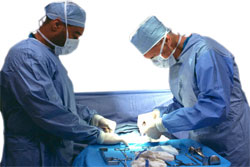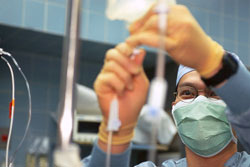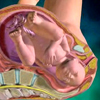Birth: Katie’s experience with caesarean birth
- ‘My Experience’: From tummy to mummy
- More information on birth
- More information on life after childbirth
- Animations on birth
From tummy to mummy: My experience with caesarean birth
 Being told you will have to receive an emergency caesarean, or even a planned caesarean, can be very daunting. If this is what you’re facing, or if you’re worried about your upcoming labour, fear not because Katie has faced it too – twice! She now has two beautiful babies who travelled safely from tummy to mummy by c-section.
Being told you will have to receive an emergency caesarean, or even a planned caesarean, can be very daunting. If this is what you’re facing, or if you’re worried about your upcoming labour, fear not because Katie has faced it too – twice! She now has two beautiful babies who travelled safely from tummy to mummy by c-section.
Baby stuck!
For Katie’s first labour, she says she didn’t have a specific birth plan and the labour was incredibly slow to begin with.
“I went to the hospital but I didn’t progress. I dilated about 4 or 5 cm but I just wasn’t dilating enough.
“They don’t really know why women don’t dilate.
“I had pethidine, and sometimes that can slow down the labour process for some women, which may have been a contributing factor.
“I ended up being in labour for more than 20 hours. They said that after that long, the baby would be getting distressed, so they made the call for an emergency caesarean.”
Time to leave the party
 So the doctors gave Katie an epidural and wheeled her to the operating theatre.
So the doctors gave Katie an epidural and wheeled her to the operating theatre.
“I was so exhausted for my first c-section. But for my second, I was actually a little bit more nervous because this time I knew it was coming and I was more conscious of all the needles I was getting,” Katie says.
“It was a little bit overwhelming.
“I wasn’t ‘out of it’, though, because the epidural just makes you numb from your waist down, with a curtain separating you from the surgery.
“When it finished the first time, I had a little girl and they took her to get checked out. Then they brought her back to me.”
For the second c-section, however, Katie was prepared.
“I had my second baby, my son, at the same hospital,” she says.
“They had all my records, so they encouraged me to have another c-section because they thought the same thing would likely happen and there’s no reason to go through the emergency again.
“So for planned caesareans, they induce the labour 10 days before the due date. This is because they don’t want to risk the chance of you going into labour.”
For both c-sections, Katie experienced no negative effects and both her babies were born healthy and strong. But women worried about this type of surgery should talk to their obstetrician. After all, knowledge is power.
A stitch in time
 Women who have had a caesarean will feel a little tender, but Katie says not to worry about the pain. The doctors certainly sort all of that out for you!
Women who have had a caesarean will feel a little tender, but Katie says not to worry about the pain. The doctors certainly sort all of that out for you!
“They keep you on painkillers with a drip in your arm. I was on about three different painkillers, so I didn’t really feel anything,” she says.
“For my first, I was in the hospital for about 4 or 5 days, and I was given a prescription to get painkillers for when I went home.
“The stitches were in for about a week and full recovery took about 2 to 3 weeks.
“You are still a little bit tender for a while, though, and you can’t run or lift anything heavy.
“It’s also a little bit painful getting up or down in the first few weeks, too.”
Bring in the A-Team
Katie says that because of this type of tenderness, you may need a little help in the first few weeks. So bring in the A-Team for some help with things like lifting and driving.
“For women getting a c-section, I would advise them to get as much support as possible for those first four weeks, especially if your baby isn’t sleeping right.
“You can’t do the washing or vacuuming. Even the shopping is hard,” she says.
For any women who have just given birth, you can always seek help from your loved ones, and if you’re feeling overwhelmed with all you have to do, then it is always a great idea to give a counsellor a call.
If you’re planning a caesarean, Katie went through it twice, with minimal pain and two beautiful babies to show for it.
More information
 | For more information about childbirth, including birth statistics, stages of labour, birthing types, who is present at a birth, how to know when you are in labour, induction and augmentation of labour, pain during childbirth and useful animations, see Birth. |
 | For more information about life after childbirth, including breastfeeding, sexuality after childbirth, postnatal depression, postpartum haemorrhage and useful videos, see Life After Childbirth. |
 | For more information on caesarean deliveries and epidural anathesia, see Birth animations. |
Have a health experience you want to share? Contact us
Dates
Created by:

 Login
Login














